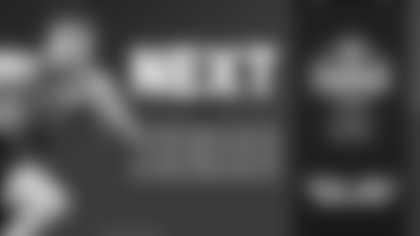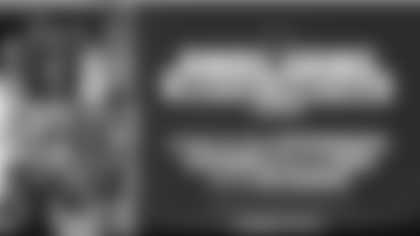A look at some of the Colts' top picks and performers through the years at safety
Colts president Bill Polian remembers well the 2004 NFL Draft. He recalls it as a draft that created much nervousness for him and left "some gray hairs."
Conversely, for then-Colts coach Tony Dungy, the 2004 draft went just as expected.
The Colts selected Bob Sanders that year in the second round, at No. 44 overall. The Colts felt strongly Sanders would be a force in the NFL. Nobody could predict he'd go on to become 2007 NFL Defensive Player of the Year, but Polian and Dungy both knew they had something special in the dynamic safety from Iowa.
But how Sanders ultimately landed in Indianapolis is an intriguing story.
Sanders had a foot injury coming out of Iowa that would need more repair before he could play in the NFL. The Colts' foot specialist, Dr. Dave Porter, told team officials he expected Sanders would be as good as new after the surgery. However, the Colts also figured many other teams would pass on the standout safety, fearing further problems with his injury.
The Colts thought they could trade down, gain a few more picks, and still get Sanders early in the second round. So Indianapolis swapped its 2004 first-rounder (29th overall) and third-rounder to Atlanta and got back a second-, third- and fourth-rounder in the same draft. The second-rounder the Colts received, No. 38 overall, was targeted for Sanders.
"So we made that trade and felt good about it," Polian said recently. "And then another trade possibility cropped up."
Pittsburgh was offering its second-rounder (No. 44 overall) and fourth-rounder for the pick at 38th overall. Polian worried Sanders would be gone by No. 44. He expressed that to Dungy, wanting to stay put.
"Tony said, 'Go ahead, do it. He'll be there. Believe me, he'll be there,' ' Polian recalled. "I said, 'OK, fine.' So we traded down and I was on pins and needles, pacing around.
"Obviously, Tony was right, as he usually was. His clairvoyance came through. And we got Bob. ... He was a tremendous pick. Thanks to Tony, we were able to garner some other picks, too."
After the surgery, Sanders' foot was never a problem again, although other injuries hindered his Indianapolis career. However, that didn't stop him from collecting 373 career tackles and six interceptions in 48 regular-season games. In his award-winning 2007 season, he totaled 132 tackles, including 74 solo, with 3.5 sacks and two interceptions.
"He and Troy Polamalu were by far the two best safeties in the National Football League when both were healthy," Polian said.
"Unfortunately, (Sanders') career has been marred by serious injury, which is no fault of his. In this salary cap era, which we presume we will have when all of this labor issue is over and done with, it was impossible for us to continue to carry Bob's contract, so we reluctantly let him go.
"But he remains for everyone around here who was fortunate enough to be around him one of the favorite guys and favorite players. And, of course, (he's) a favorite of the fans because of his incredible ability to hit people, his hell-bent-for-leather style of play, his infectious hitting ability which just raised the level of everyone around him. He is a unique guy."
ANTOINE BETHEA LEAVES HIS IMPRINT
Heading into the 2006 draft, Polian and his trusted aide and longtime friend, Dom Anile, were looking for a cornerback. As they watched a videotape of Antoine Bethea from Howard University, their enthusiasm grew.
"We took it to Tony (Dungy)," Polian recalled recently, "and I said, 'You need to look at this tape. I don't know whether this young guy is better at safety or corner. I think he can do both, but you're the expert. You decide.' '
Dungy agreed with his scouts. Bethea possessed talent and strong instincts. The team drafted him in the sixth round, but the question remained: Is he an NFL cornerback or a safety, which was his position at Howard.
In part because Bethea was coming from a smaller football program and the Colts wanted him to be in his comfort zone, Dungy positioned him first at safety at the team's spring mini-camp.
"Comes the first day of mini-camp, in the morning practice, and Antoine had an interception," Polian said. "In the second practice, he has two interceptions. After the second one, Tony walked over to me and said, 'I think we'll leave him at safety.' '
Bethea has been there ever since. He has totaled 552 tackles and 12 interceptions in just five seasons. He has played twice in the Pro Bowl.
"He's a true pro, prepared, (and) you never hear a word out of him except to encourage other people to try to be their best," Polian said. "He's respected by all of his peers and there is no harder worker on this team. He's a great player and worthy of the Pro Bowl selection that came his way two years ago, and he should have made it last year.
"He clearly has exceeded our expectations, but I have to say that he was a guy from Day One when we took him, we were really convinced he would be a good player."
PRIOR KNEW HOW TO PLAY CENTER FIELD
A few years before Sanders and Bethea came along, Mike Prior patrolled the Colts' secondary at safety. Prior signed with the Colts in 1987 after he was drafted in the 1985 seventh round by Tampa Bay and later released. He quickly jumped on his new opportunity, enjoying a strong debut season in Indianapolis and going on to make a remarkable 27 interceptions and nine fumble recoveries in 86 Colts games.
"I enjoyed it with the Colts," said Prior, who now works as the team's Youth Football Commissioner. "I was able to play a lot of coverages, kind of like in college. I was able to read the ball and make tackles. I hated missing tackles.
"I grew up watching Gary Fencik and Doug Plank (with the Chicago Bears). I'd always try to get to the ball-carrier before he hit the ground. You want to be a part of it. You want to take the correct angles to get there. Our system really helped me do that."
George Catavolos, then the Colts' secondary coach, knew the team had an instinctive, solid player in Prior. The 6-foot, 200-pounder also was a star center fielder in baseball at Illinois State and was drafted by three different Major League organizations. When the Colts positioned Prior in deep center field in the secondary, he seldom let them down, recording three different seasons with six interceptions.
OTHER NOTABLE COLTS SAFETIES AT A GLANCE
Here's a look at some of the team's top safeties, listed chronologically:
Nesby Glasgow, 1979 eighth-rounder: Glasgow, from Washington, recorded 12 interceptions and 10 fumble recoveries during nine Colts seasons. Early in his career, he also returned punts and kickoffs, averaging 8.2 yards on the former and 22.7 on the latter. As a rookie in '79, Glasgow returned a punt 75 yards for a touchdown against New England.
Tate Randle, 1983 waiver acquisition: From Texas Tech, Randle made five interceptions and four fumble recoveries over four Colts seasons. He also made one of the most memorable plays of the team's early years in Indianapolis. It came in 1986 at Atlanta after the Colts started the season 0-13. Ron Meyer, coaching his first Colts game, saw his team trailing 23-21 in the final minute and instructed his punt receiving unit to go all-out for a block. Randle got a hand on Rick Donnelly's punt and Eugene Daniel picked it up for the winning score with 20 seconds left. The play injected new life into the Colts. They went on to win twice more and finish 3-13 before making their first playoff appearance as an Indianapolis club in 1987.
Jason Belser, 1992 eighth-rounder: Belser, from Oklahoma, played nine seasons with the Colts, totaling 13 interceptions (three returned for touchdowns), seven forced fumbles and 10 fumble recoveries. Belser, whose father, Ceasar, played for the Kansas City Chiefs, thrived on his savvy as much as physical talent during a Colts career that included 785 tackles. "And he was a hitter; he just loved to hit," Mike Prior remembered about his old teammate.















